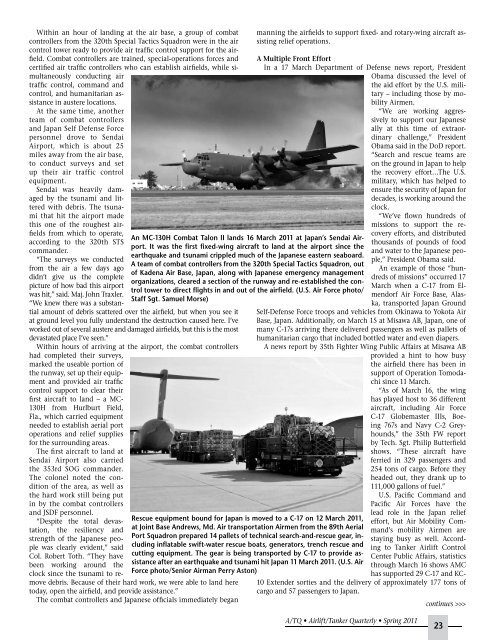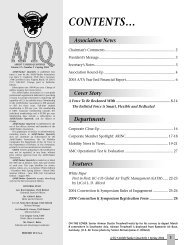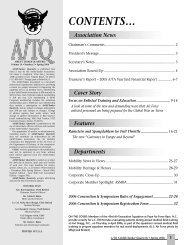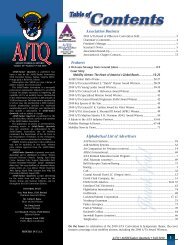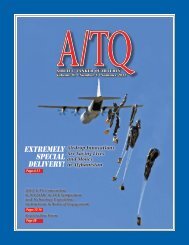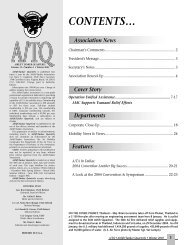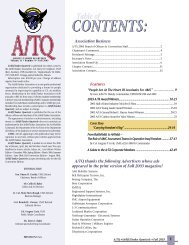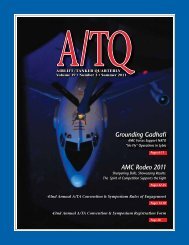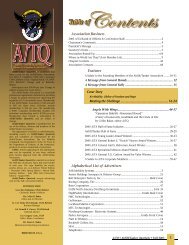A New Generation of Boeing Tankers - Airlift/Tanker Association
A New Generation of Boeing Tankers - Airlift/Tanker Association
A New Generation of Boeing Tankers - Airlift/Tanker Association
Create successful ePaper yourself
Turn your PDF publications into a flip-book with our unique Google optimized e-Paper software.
Within an hour <strong>of</strong> landing at the air base, a group <strong>of</strong> combat<br />
controllers from the 320th Special Tactics Squadron were in the air<br />
control tower ready to provide air traffic control support for the airfield.<br />
Combat controllers are trained, special-operations forces and<br />
certified air traffic controllers who can establish airfields, while simultaneously<br />
conducting air<br />
traffic control, command and<br />
control, and humanitarian assistance<br />
in austere locations.<br />
At the same time, another<br />
team <strong>of</strong> combat controllers<br />
and Japan Self Defense Force<br />
personnel drove to Sendai<br />
Airport, which is about 25<br />
miles away from the air base,<br />
to conduct surveys and set<br />
up their air traffic control<br />
equipment.<br />
Sendai was heavily damaged<br />
by the tsunami and littered<br />
with debris. The tsunami<br />
that hit the airport made<br />
this one <strong>of</strong> the roughest airfields<br />
from which to operate,<br />
according to the 320th STS<br />
commander.<br />
“The surveys we conducted<br />
from the air a few days ago<br />
didn’t give us the complete<br />
picture <strong>of</strong> how bad this airport<br />
was hit,” said. Maj. John Traxler.<br />
“We knew there was a substantial<br />
amount <strong>of</strong> debris scattered over the airfield, but when you see it<br />
at ground level you fully understand the destruction caused here. I’ve<br />
worked out <strong>of</strong> several austere and damaged airfields, but this is the most<br />
devastated place I’ve seen.”<br />
Within hours <strong>of</strong> arriving at the airport, the combat controllers<br />
had completed their surveys,<br />
marked the useable portion <strong>of</strong><br />
the runway, set up their equipment<br />
and provided air traffic<br />
control support to clear their<br />
first aircraft to land – a MC-<br />
130H from Hurlburt Field,<br />
Fla., which carried equipment<br />
needed to establish aerial port<br />
operations and relief supplies<br />
for the surrounding areas.<br />
The first aircraft to land at<br />
Sendai Airport also carried<br />
the 353rd SOG commander.<br />
The colonel noted the condition<br />
<strong>of</strong> the area, as well as<br />
the hard work still being put<br />
in by the combat controllers<br />
and JSDF personnel.<br />
“Despite the total devastation,<br />
the resiliency and<br />
strength <strong>of</strong> the Japanese people<br />
was clearly evident,” said<br />
Col. Robert Toth. “They have<br />
been working around the<br />
clock since the tsunami to remove<br />
debris. Because <strong>of</strong> their hard work, we were able to land here<br />
today, open the airfield, and provide assistance.”<br />
The combat controllers and Japanese <strong>of</strong>ficials immediately began<br />
manning the airfields to support fixed- and rotary-wing aircraft assisting<br />
relief operations.<br />
A Multiple Front Effort<br />
In a 17 March Department <strong>of</strong> Defense news report, President<br />
Obama discussed the level <strong>of</strong><br />
the aid effort by the U.S. military<br />
– including those by mobility<br />
Airmen.<br />
“We are working aggressively<br />
to support our Japanese<br />
ally at this time <strong>of</strong> extraordinary<br />
challenge,” President<br />
Obama said in the DoD report.<br />
“Search and rescue teams are<br />
on the ground in Japan to help<br />
the recovery effort…The U.S.<br />
military, which has helped to<br />
ensure the security <strong>of</strong> Japan for<br />
decades, is working around the<br />
clock.<br />
“We’ve flown hundreds <strong>of</strong><br />
missions to support the recovery<br />
efforts, and distributed<br />
thousands <strong>of</strong> pounds <strong>of</strong> food<br />
and water to the Japanese people,”<br />
President Obama said.<br />
An example <strong>of</strong> those “hundreds<br />
<strong>of</strong> missions” occurred 17<br />
March when a C-17 from Elmendorf<br />
Air Force Base, Alaska,<br />
transported Japan Ground<br />
Self-Defense Force troops and vehicles from Okinawa to Yokota Air<br />
Base, Japan. Additionally, on March 15 at Misawa AB, Japan, one <strong>of</strong><br />
many C-17s arriving there delivered passengers as well as pallets <strong>of</strong><br />
humanitarian cargo that included bottled water and even diapers.<br />
A news report by 35th Fighter Wing Public Affairs at Misawa AB<br />
provided a hint to how busy<br />
the airfield there has been in<br />
support <strong>of</strong> Operation Tomodachi<br />
since 11 March.<br />
“As <strong>of</strong> March 16, the wing<br />
has played host to 36 different<br />
aircraft, including Air Force<br />
C-17 Globemaster IIIs, <strong>Boeing</strong><br />
767s and Navy C-2 Greyhounds,”<br />
the 35th FW report<br />
by Tech. Sgt. Philip Butterfield<br />
shows. “These aircraft have<br />
ferried in 329 passengers and<br />
254 tons <strong>of</strong> cargo. Before they<br />
headed out, they drank up to<br />
111,000 gallons <strong>of</strong> fuel.”<br />
U.S. Pacific Command and<br />
Pacific Air Forces have the<br />
An MC-130H Combat Talon II lands 16 March 2011 at Japan’s Sendai Airport.<br />
It was the first fixed-wing aircraft to land at the airport since the<br />
earthquake and tsunami crippled much <strong>of</strong> the Japanese eastern seaboard.<br />
A team <strong>of</strong> combat controllers from the 320th Special Tactics Squadron, out<br />
<strong>of</strong> Kadena Air Base, Japan, along with Japanese emergency management<br />
organizations, cleared a section <strong>of</strong> the runway and re-established the control<br />
tower to direct flights in and out <strong>of</strong> the airfield. (U.S. Air Force photo/<br />
Staff Sgt. Samuel Morse)<br />
lead role in the Japan relief<br />
effort, but Air Mobility Command’s<br />
mobility Airmen are<br />
staying busy as well. According<br />
to <strong>Tanker</strong> <strong>Airlift</strong> Control<br />
Center Public Affairs, statistics<br />
through March 16 shows AMC<br />
has supported 29 C-17 and KC-<br />
10 Extender sorties and the delivery <strong>of</strong> approximately 177 tons <strong>of</strong><br />
cargo and 57 passengers to Japan.<br />
Rescue equipment bound for Japan is moved to a C-17 on 12 March 2011,<br />
at Joint Base Andrews, Md. Air transportation Airmen from the 89th Aerial<br />
Port Squadron prepared 14 pallets <strong>of</strong> technical search-and-rescue gear, including<br />
inflatable swift-water rescue boats, generators, trench rescue and<br />
cutting equipment. The gear is being transported by C-17 to provide assistance<br />
after an earthquake and tsunami hit Japan 11 March 2011. (U.S. Air<br />
Force photo/Senior Airman Perry Aston)<br />
continues >>><br />
A/TQ • <strong>Airlift</strong>/<strong>Tanker</strong> Quarterly • Spring 2011<br />
23


